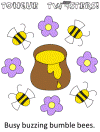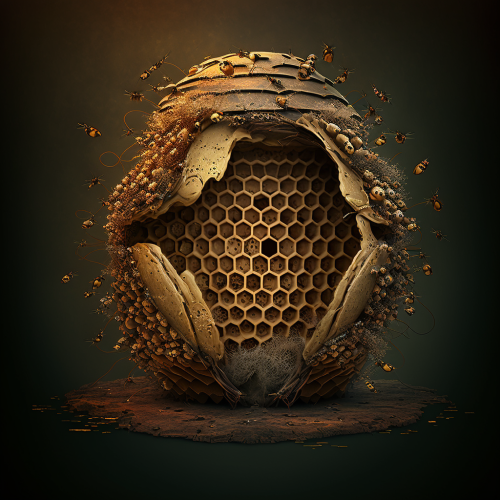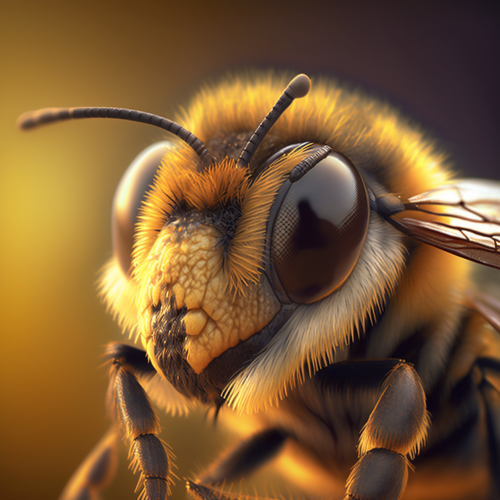DLTK's Crafts for Kids
World Bee Day, May 20th
 World Bee Day is an annual event celebrated on May 20th, established by the United Nations to raise awareness about the importance of bees and other pollinators in our ecosystems and food production. Bees play a crucial role in pollinating plants, which is essential for the growth of the fruits, vegetables, and nuts that make up a significant portion of our diet. On World Bee Day, we come together to appreciate these hardworking insects and learn more about how we can help protect them and their habitats.
World Bee Day is an annual event celebrated on May 20th, established by the United Nations to raise awareness about the importance of bees and other pollinators in our ecosystems and food production. Bees play a crucial role in pollinating plants, which is essential for the growth of the fruits, vegetables, and nuts that make up a significant portion of our diet. On World Bee Day, we come together to appreciate these hardworking insects and learn more about how we can help protect them and their habitats.
About World Bee Day:
World Bee Day was officially declared by the United Nations in 2017, with the first celebration held in 2018. The date, May 20th, was chosen to honor the birth of Anton Janša, a Slovenian beekeeper and pioneer of modern apiculture. The day is observed with various events and activities, including educational programs, workshops, and community gatherings, which aim to inform the public about the vital role bees play in our ecosystems and the challenges they face.
Why Bees Need Our Help:
Bees and other pollinators face numerous challenges, including habitat loss, pesticide exposure, climate change, and disease. These threats have led to declines in bee populations worldwide, putting our food supply and ecosystems at risk. By raising awareness about the importance of bees and promoting sustainable practices, we can help protect these vital pollinators and ensure their survival.
Bee Activities for Kids:
Bumblebee Coloring Pages: |
|
 |
|
Bumblebee Crafts for Kids: | |
 |
|
 |
|
 |
|
 |
even babies can contribute their fingerprints |
 |
|
 |
|
 |
Ages 8+ |
 |
|
 |
|
Bumblebee Poems, Songs and Nursery Rhymes: |
|
 |
Nursery Rhyme: Five Busy Honey Bees |
 |
Poem: Swaying in My Hammock |
 |
Tongue Twister: Busy Buzzing Bumblebees |
 |
|
 Fun Facts for Kids about Bees:
Fun Facts for Kids about Bees:
- There are over 20,000 known species of bees worldwide, and they come in various sizes, shapes, and colors.
- Bees communicate with each other through a unique "dance" called the waggle dance, which helps them share information about the location of food sources.
- Bees have two stomachs – one for digesting food and another for storing nectar collected from flowers.
- The queen bee can lay up to 2,000 eggs per day and can live for up to five years, while worker bees usually live for only a few weeks.
- Bees are excellent navigators and can remember the locations of thousands of flowers, allowing them to find their way back to their hive even after traveling long distances.
- Honey never spoils: Did you know that honey has a natural preservative quality that allows it to last indefinitely without going bad? Archaeologists have even found pots of honey in ancient Egyptian tombs that are over 3,000 years old and still safe to eat! This amazing property of honey is due to its low water content and high sugar concentration, which create an environment where bacteria and other microorganisms can't survive.
Famous Bees from Myths, Folktales and Legends:
Throughout history, bees have been revered and have played important roles in myths, legends, and folklore from various cultures. Here are some examples of famous bees or bee-related stories from myths and legends:
- The Bees of Artemis: In Greek mythology, Artemis, the goddess of the hunt, was often associated with bees. It was believed that she could transform herself into a bee, and her priestesses, known as "Melissae" (meaning "bees"), were said to be sacred bees who served the goddess.
- Melissa, the Nymph: In Greek mythology, Melissa was a nymph who discovered honey and taught humans how to harvest it. She was also said to have nursed the infant Zeus with honey when he was hidden from his father, Cronus.
-
 The Bee in Ancient Egyptian Mythology: The bee was considered sacred in ancient Egypt, and honey was believed to be a gift from the gods. The hieroglyph for the bee was used as a symbol of royalty and represented the Pharaoh's power. According to some myths, bees were created from the tears of the sun god Ra.
The Bee in Ancient Egyptian Mythology: The bee was considered sacred in ancient Egypt, and honey was believed to be a gift from the gods. The hieroglyph for the bee was used as a symbol of royalty and represented the Pharaoh's power. According to some myths, bees were created from the tears of the sun god Ra. - Bhramari Devi: In Hindu mythology, Bhramari Devi is the goddess of bees, often depicted surrounded by bees or wearing a garment of bees. She is believed to protect and bless her devotees, offering them a harmonious and prosperous life.
- Bees in Celtic Mythology: In Celtic mythology, bees were considered messengers between the human and spirit worlds. They were associated with wisdom, knowledge, and poetic inspiration. The Celts believed that the honey produced by bees was a source of spiritual sustenance that could connect them to the divine.
- The Mead of Poetry: In Norse mythology, there is a story about a magical mead made from the blood of a wise being named Kvasir. This mead, when consumed, granted the drinker the gift of poetry and wisdom. Bees were believed to be responsible for the production of this mead, as they transformed Kvasir's blood into honey.
- There is an Aesop's fable that features bees, titled "The Bees and Wasps, and the Hornet." In this fable, bees and wasps are in a dispute over which group makes the best honey. To resolve the conflict, they ask a hornet to be the judge. The hornet agrees and suggests a contest to determine the winner. Each group should make a batch of honey, and the hornet will taste both to decide which is the best. The bees and wasps accept the challenge and get to work.
However, the hornet, being cunning and deceitful, consumes all the honey produced by both the bees and the wasps. In the end, the hornet flies away without declaring a winner, leaving the bees and wasps with nothing.
The moral of this fable is that we should be cautious when involving others in our disputes, as they may take advantage of the situation for their own benefit.
These examples demonstrate the significant role bees have played in myths, legends, and cultural beliefs throughout history. Their association with wisdom, divine gifts, and transformation reflects the importance of bees in human societies and the reverence with which they have been regarded.
 Conclusion:
Conclusion:
World Bee Day is a time to celebrate the incredible work of bees and other pollinators, and to learn more about the essential role they play in our ecosystems and food production. By participating in events, sharing information, and supporting conservation efforts, we can help ensure the survival of these vital insects and the countless plants that depend on them for pollination. So let's create a buzz and join the global celebration of these remarkable pollinators that help our world thrive!